Why Do Some Cannabis Buds Turn Purple?
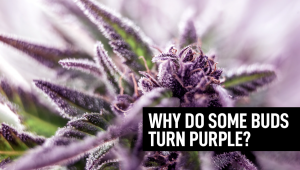
- 1. What are anthocyanins?
- 2. How do anthocyanins work?
- 3. Benefits of athocyanin
- 4. What parts of a cannabis plant can turn purple?
- 5. Purple genetics
- 6. Our purple strains
- 7. In conclusion
Before breeding became popular, the only way to get purple buds was by growing cannabis seeds in cold temperatures but nowadays you can find purple strains that develop not only purple but pink, red, and blue hues without doing anything special. Modern plants have been selected to have an increased Anthyocianins production, which makes them show unique colors without doing anything special during their growth.
When most growers think of cannabis, they imagine plants with luscious green foliage and green flowers coated in glandular trichomes and viscous resin. However, not all cannabis varieties fit this typical description. The majority of cultivars are green in appearance because their leaves contain higher quantities of chlorophyll. This photosynthetic pigment plays a crucial role in the process of photosynthesis—the conversion of sunlight into sugars is broken down into a source of cellular energy.
Chlorophyll makes plants appear green because they reflect green light back into our eyes. Plants that appear purple still contain high levels of chlorophyll, or else they won’t be able to conduct the vital process of photosynthesis. However, they contain such high levels of anthocyanin that they reflect higher amounts of purple light, giving them an attractive and striking appearance. But what exactly are anthocyanins? What role do they play in plants? And what part of the cannabis plant can turn purple? Find out all of the answers to these questions below and learn everything you need to know about these fascinating phytochemicals.
1. What are Anthocyanins?
Anthocyanins are water-soluble pigments classified as flavonoids whose primary function is to protect the surface of the buds against UV rays. This compound usually manifests as purple but can display a variety of different colors such as blue, red, pink, and black depending on the pH level throughout your plant’s life cycle and can be found not only on cannabis but also on several fruits, plants, and vegetables such as grapes, cabbage, and eggplants. Also, because it is a flavonoid, it is said to play a role in the effect a cannabis plant can have, just like terpenes do. Anthocyanins are made in plants via the flavonoid pathway within the cytoplasm of plant cells.
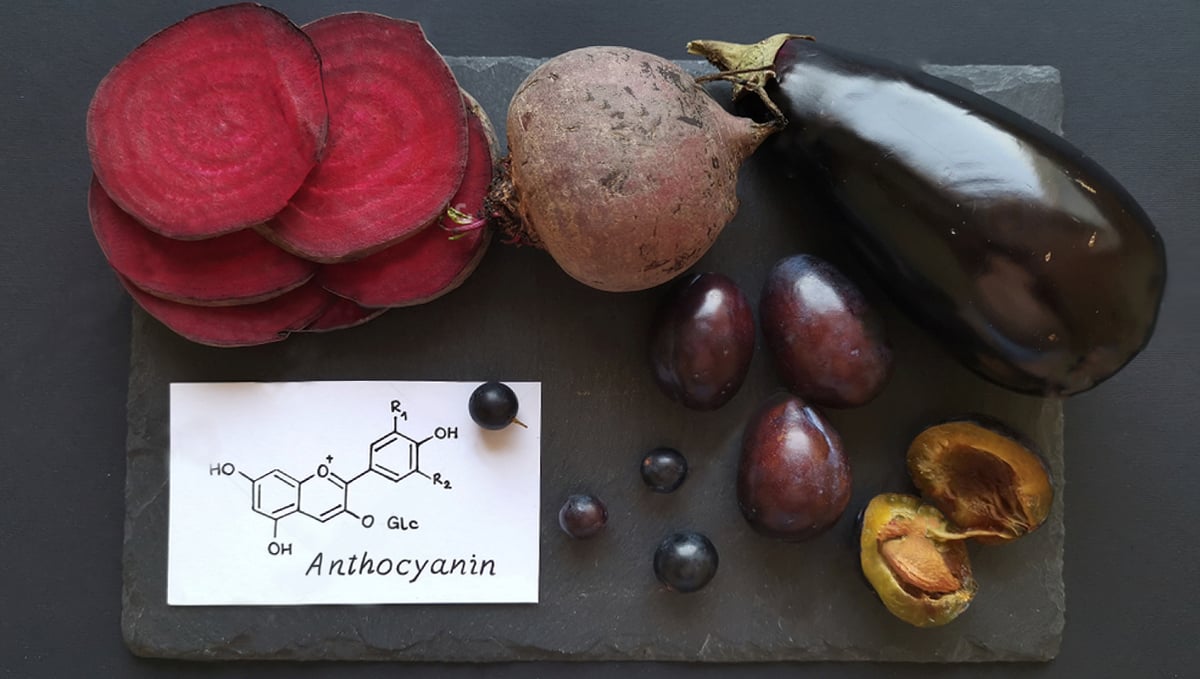
They are found in cells in many different areas of plant tissue, including the leaves, roots, stems, petioles, and flowers. After creation via the flavonoid pathway, these molecules accumulate within an area of the cell called the vacuole. This large organelle also stores water. When filled, they take up most of the space available within the cell and give plants the turgidity that they need to spread out their leaves. When enough anthocyanin is stored within the vacuole of a plant cell, the cell will display a purple appearance. But why exactly do cannabis plants produce anthocyanins in the first place? Well, they serve a much greater purpose than merely looking nice. However, plants that appear bright purple do work better at attracting specific types of pollinators and beneficial insects. Looks aside, anthocyanins are essentially a type of sunscreen for plants. Although they aren’t directly involved in photosynthesis, they do help to protect the photosynthetic apparatus by reflecting excess levels of strong light. But the benefits of these vibrantly colored molecules don’t stop there. While they help to attract beneficial insects, they also serve as a form of chemical plant defense against grazing pests and larger herbivores. Anthocyanins also work as antioxidants. That is, they help to neutralize damaging free radicals that form in plant tissues and stop them from causing oxidative stress. When plants are injured from exposure to excess light, anthocyanins step in to clean up any reactive oxygen species that form.
2. How do anthocyanins work?
Anthocyanins are not produced at all times, when a certain strain has been selected to change colors, it will stop producing chlorophyll in the last weeks of the flowering stage which will allow the pigments to show even more.
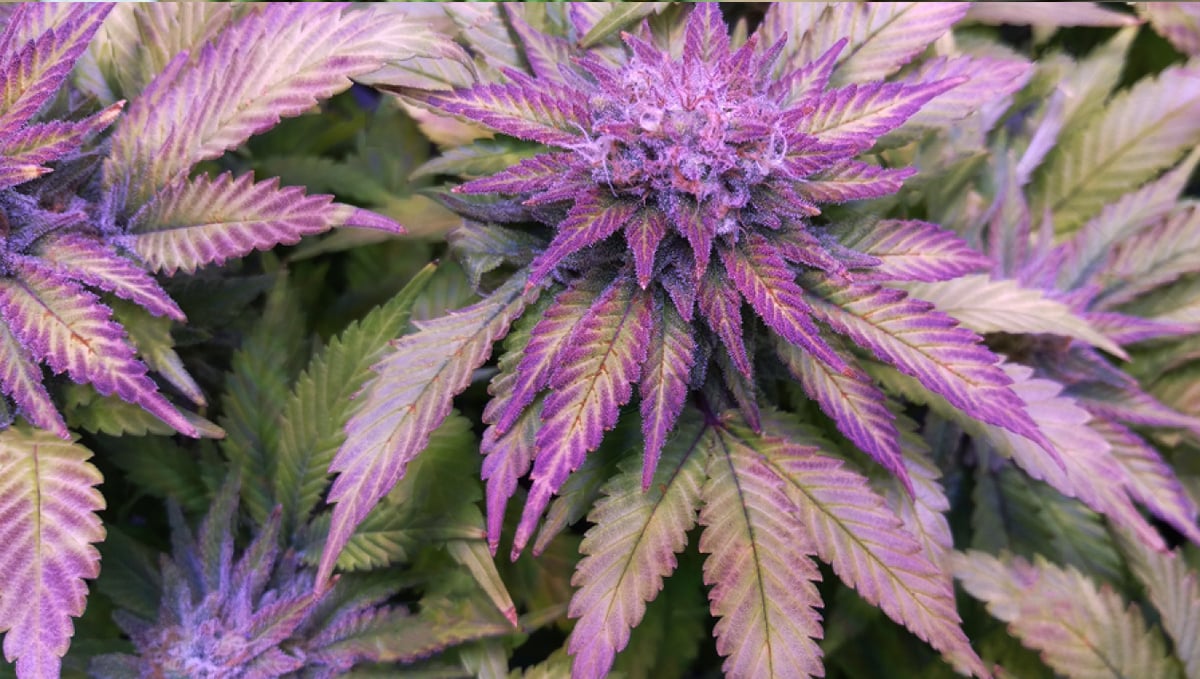
Normally, cannabis plants are green because they use chlorophyll to absorb light but in its absence, they can use anthocyanins in its place and will absorb all wavelengths of the lights spectrum, except the blue (or indigo) spectrum and because it’s the dominant pigment, your plant will turn purple.
3. Benefits of athocyanin
Recent studies showed that these compounds have an affinity with cannabinoid receptors, anthocyanins are known to be antioxidants and have analgesic, anti-inflammatory, and neuroprotective properties, although there are ongoing studies so it’s too early to confirm if anthocyanins really bring benefits.

Lots of people claim that consuming foods with this compound can increase longevity, prevent dementia and cancer so even though it's not confirmed, you can have an idea of the benefits. In the not-so-distant past, cannabinoids such as THC and CBD got all the attention when it came to cannabis phytochemicals. However, research has shown that other constituents found within cannabis flowers also play an important role when it comes to the effects of particular strains. For example, terpenes appear to synergise with cannabinoids through the so-called entourage effect. Advocates of full-spectrum extracts (preparations that possess all of the beneficial chemicals found in cannabis) also believe that anthocyanins and other flavonoids play an important role in the overall effects of a strain.
4. What parts of a cannabis plant can turn purple?
Depending on the amount of anthocyanins and where they’re located, your whole plant can turn purple this is not very common, although possible.
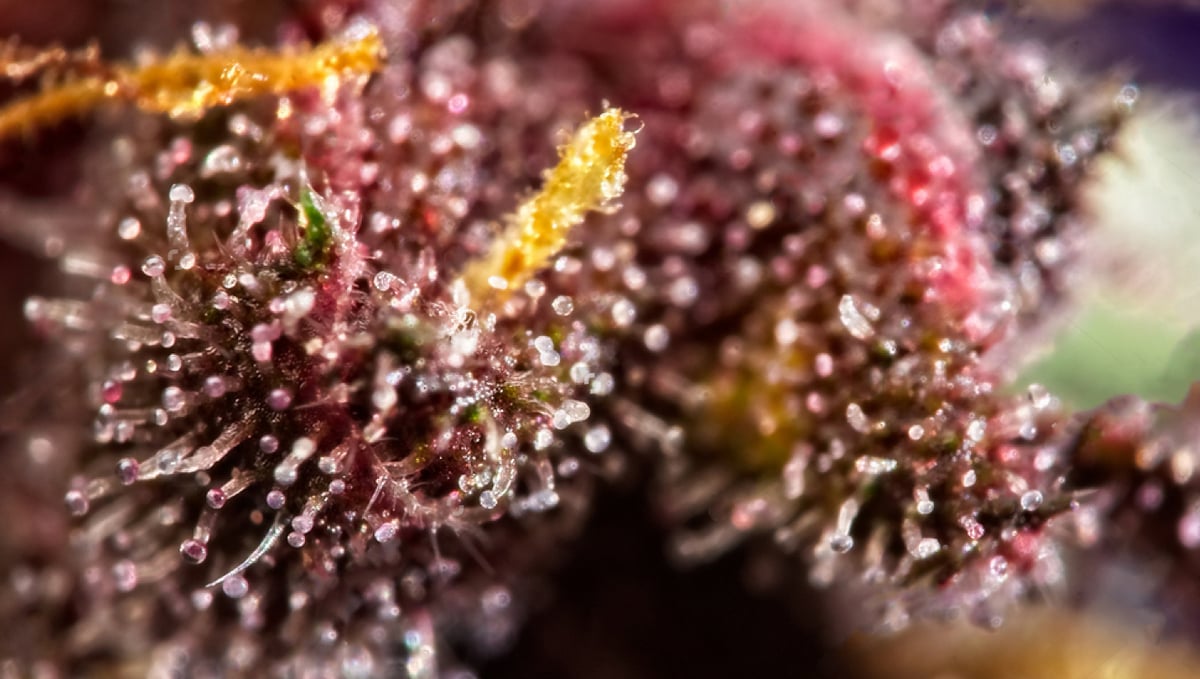
Normally you will see certain parts of your cannabis plant changing color and not the whole plant.
| Part of the plant | Importance | Colors |
|---|---|---|
| Pistils | White hairs you see on female plants, responsible for catching pollen. | Usually orange but can turn pink or purple. |
| Calyxes | Seed pods that make up the buds, also protect the seeds. | Can exhibit black, purple, pink, blue, and red hues. |
| Leaves | Perform photosynthesis for plant growth (aka fan leaves). | Can display red, pink, purple, blue, and even black tones. |
| Trichomes | Trichomes produce and store cannabinoids and terpenes. | Usually white but sometimes can turn black or purple. |
All of these parts of a cannabis plant can turn purple and it usually depends on the genetics and the environment they’re grown in, even though the genetics have been specially selected, you should also try to provide the best environment to encourage your cannabis plants to exhibit the unusual colors.
5. Purple genetics
The best way to end up with beautiful purple (or black, pink, etc..) buds is to start with the right genetics, nowadays most seedbanks offer colorful strains that don’t depend on anything other than proper care to end up turning purple.
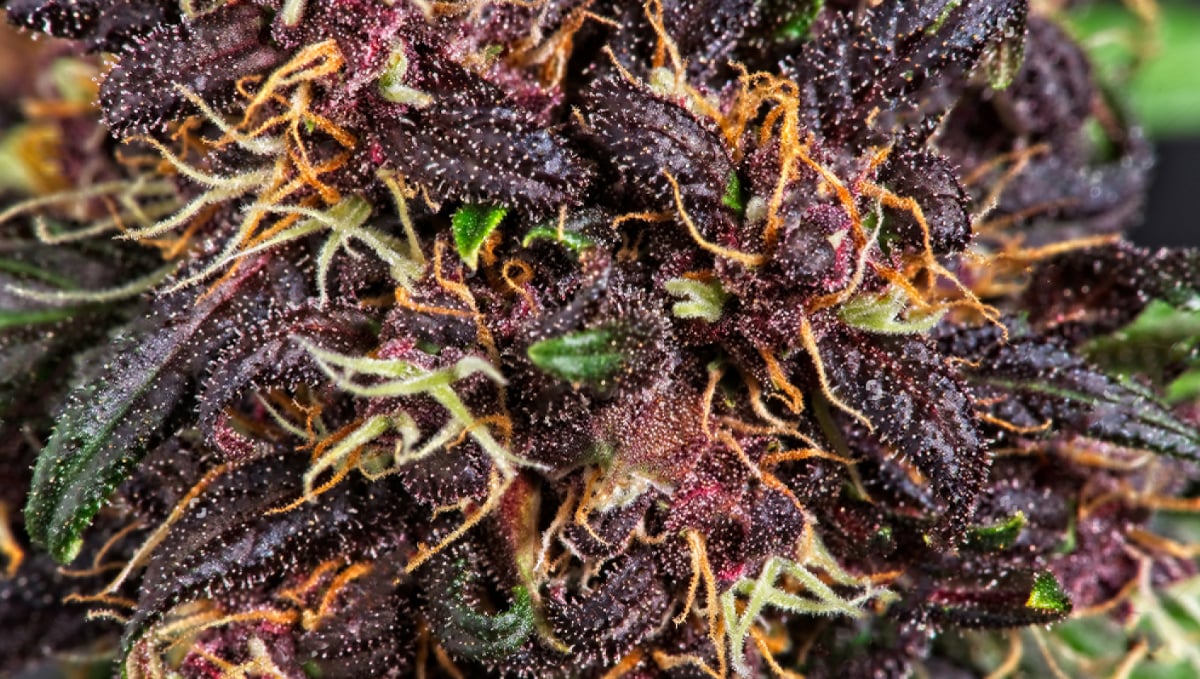
Have in mind that most plants contain anthocyanins but won’t exhibit different colors due to the low amount and when growing purple genetics, you won’t see a difference until the last couple of weeks before harvesting when flushing the nutrients off your plant.
All of these strains have been specially selected and bred for their unique colors, this happens because breeders select the plants that have a tendency to produce higher levels of anthocyanins, but this doesn’t mean that they will turn purple on 100% of the cases.
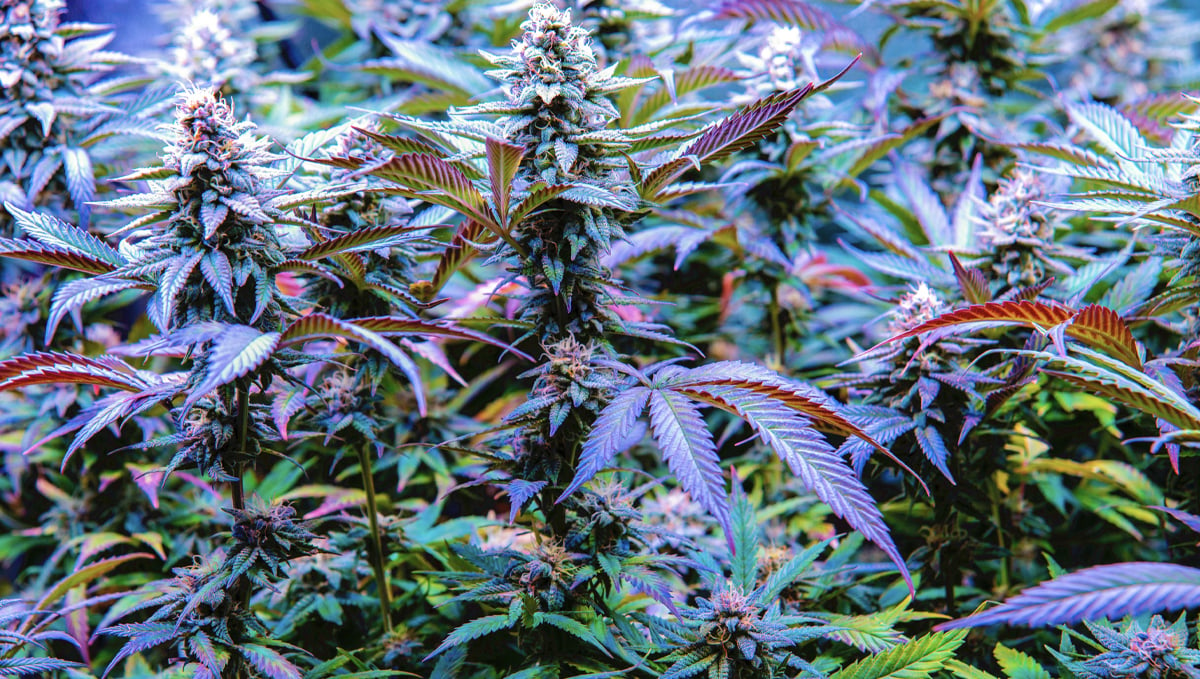
Even though a certain strain can be purple, they may still need certain conditions to exhibit other colors, although it will be way easier to achieve it than with other genetics, those factors include:
- Temperature
- Humidity
- Genetics
- pH level
- Nutrient amount
To encourage your plant to display unique colors, you should provide lower temperatures because cold causes chlorophyll to break down and can influence your plant into producing more anthocyanins, ideally, there should be a difference of about 10-15°C between daytime and nighttime temperatures for this to happen but it can depend from strain to strain. Also, providing these big changes in temperature can also help non-purple strains to change colors, although it won’t work with all plants.
Keep in mind that if you do decide to lower the temps to try to coax out some extra color changes, it's best to make these reductions slowly. If you, all of a sudden, drop the temps by 10 to 15°C you may cause some serious shock to the plant. You also increase the likelihood of the plant developing mold issues, especially if the humidity levels are not strictly monitored. Try it if you are feeling adventurous, but remember to keep a close eye on the ladies to make sure they don't freak out.
Is it true that purple weed is more potent than regular bud?
Thanks to popular culture and the worldwide rumor mill, there is a long-standing belief that purple buds are stronger than your everyday weed. But how true is this? Well, in terms of concrete scientific proof - there really is none at all. That's not to say the anthocyanins that turn the weed purple play no role at all in how the high feels, but there is zero evidence pointing towards purple sticky-icky providing a stronger or longer-lasting high. With the recent changes concerning cannabis law, we are thankfully seeing our favorite plant being put through rigorous scientific studies at a much higher rate than ever before. What we can say for certain is that anthocyanins are mostly processed by the digestive system, so there may be some benefits when consuming purple weed in edible form.
A different, and maybe more important question we can ask is “is purple weed better?" That really comes down to personal preference. For some of us weed enthusiasts, the satisfaction we seek is as much about the look and smell of a certain bud as it is the cerebral effects. It's not always about how strong the weed is, or how long the high will last. There's a certain beauty in purple weed varieties that you simply don't find elsewhere.
There is also a strong connection between purple weed and popular culture, in particular hip-hop and rap but also with classic stoner films from the 2000s. This connection can provide smokers with some feelings of nostalgia that you don't get from other strains, and may also mean that the myth of purple dank may never totally disappear, even if firm scientific evidence arises showing it has no true difference from regular old green and orange bud. And don't forget the bag appeal! Is there anything better than scoring a big bag of sticky, stinky, gorgeous purple flowers that make you feel fantastic? We think not.
6. Our purple strains
If you’re looking for purple genetics to grow in your next grow cycle, don’t look further, we have several purple strains that have been genetically selected to exhibit unique colors without the need to do anything extra, such as our Blackberry Auto.
Tight buds with an intense purple color with a very characteristic smell, with lemon or forest fruits. - Thejusepas
Now, if you're looking for something with a strong cerebral effect, we recommend our LSD-25 Auto.
This beautiful purple hybrid will develop dark orange pistils on mostly dark purple buds, exhibiting sometimes light purple hues with stunning yellow, and reddish-pink colors on the leaves at the end of the flowering stage and especially after properly flushing.
As you can see in the video below, when the flowers begin to form, the buds will slowly start turning purple and when your plant is ready for harvest, the buds will completely exhibit a dark purple color with sometimes lighter hues throughout them.
"...LSD-25 produced some of the best looking dark purple cannabis buds I have ever seen." - Freeglocks
This is because our purple varieties have been genetically selected throughout the years to develops anthocyanin-rich autoflowers, so without doing anything extra, you can expect a beautiful purple color when nearing harvest.
7. In conclusion
Growing colorful buds won’t make them more potent but they will certainly have a better appeal and depending on the different hues, will end in flowers that you won’t even want to smoke, just stare at them all day long. If you have grown one of our purple strains before, share your experience with fellow growers, feel free to leave a comment in the comment section below!
External References:
- Anthocyanins: From the Field to the Antioxidants in the Body. - Bendokas, Vidmantas & Stanys, Vidmantas & Mazeikiene, Ingrida & Trumbeckaite, Sonata & Baniene, Rasa & Liobikas, Julius. (2020).
- Anthocyanins in human health. - Shemet, Sergiy & Eliseeva, Tatiana. (2020).








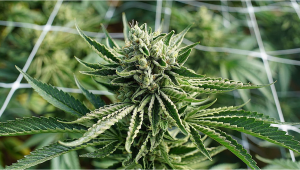
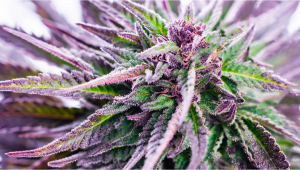
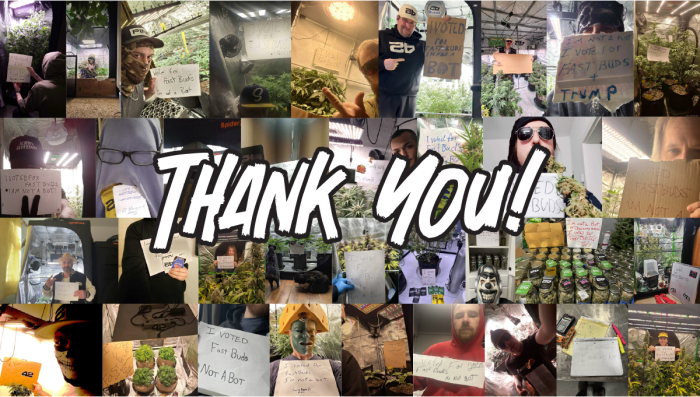

Comments